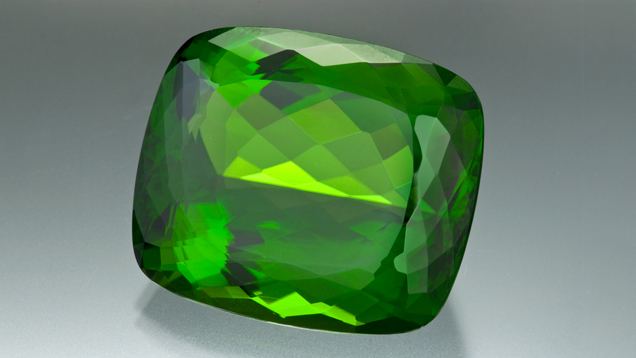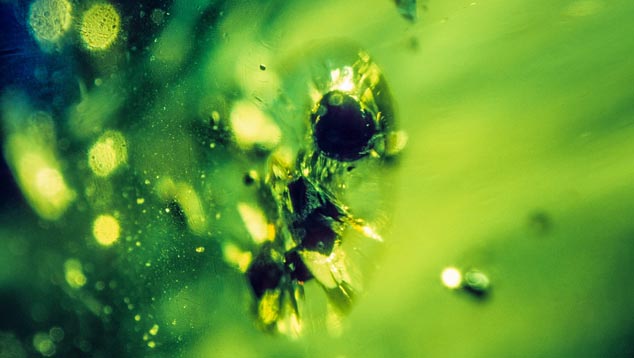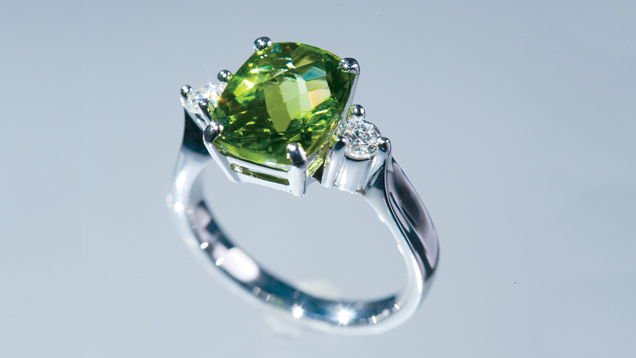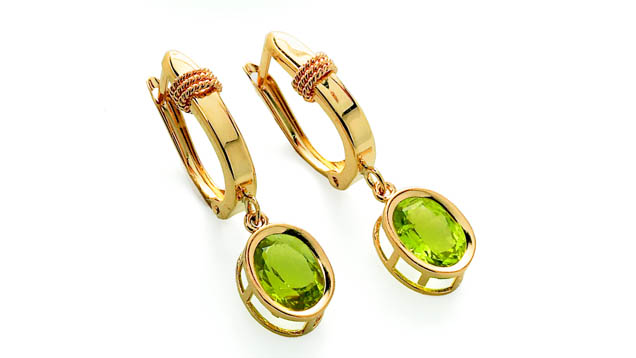Peridot Quality Factors

Color
Peridot’s color ranges from pure green to yellowish green to greenish yellow. The finest hue is green without any hint of yellow or brown. The gem’s colors tend to be at their finest in stones weighing 10 carats and above. Lower-quality peridot is brownish.
Pure green stones are rare, and most peridots are more yellowish green. The higher-quality stones have an intense color. Most of the stones with the finest color come from Myanmar and Pakistan.
Clarity
Most of the better-quality, calibrated material and larger single pieces on the market have no eye-visible inclusions, with tiny black spots—actually minute mineral crystals—visible under magnification. Other inclusions common in peridot are reflective, disk-shaped inclusions called “lily pads.”

These disk-like fracture inclusions in peridot are descriptively called lily pads.
Readily visible inclusions, especially the dark spots, lower the value of peridot. There’s a dramatic drop in value for light-colored material with prominent dark inclusions.
If black mineral crystals in peridot are visible to the eye, they lower the stone’s value.
CutPeridot is cut in a wide variety of shapes and cutting styles. Production includes all the standard gem shapes such as round, oval, pear, cushion, triangle, and marquise shapes.

Peridot is popular for some uncommon cuts like the checkerboard. - Courtesy Gem Center Northwest
Cutting styles are also well represented. Brilliant cuts with triangular and kite-shaped facets, step cuts with concentric rows of parallel facets, and mixed cuts usually consisting of brilliant-cut crowns and step-cut pavilions are all common. Designer cuts fashioned by hand and machine are popular, as well as cabochons, beads, and carvings.
Peridot is commonly cut in standard shapes and sizes for jewelry. - Courtesy Rio Grande
Carat WeightStandard peridot cuts for the jewelry industry include a wide range of shapes and sizes. The gem is inexpensive in smaller sizes, but prices rise for gems above 10×8 mm. The finest large peridots come from Myanmar— formerly Burma—and, more recently, from a source high in the Himalayas of Pakistan. More-standard sizes and qualities come mostly from the United States (Arizona) and China.

The peridot crystals weigh 128.82 and 393.83 carats, while the cut stones weigh
18.50 to 64.61 carats. All are from Pakistan. - Courtesy Shades of the Earth
18.50 to 64.61 carats. All are from Pakistan. - Courtesy Shades of the Earth



